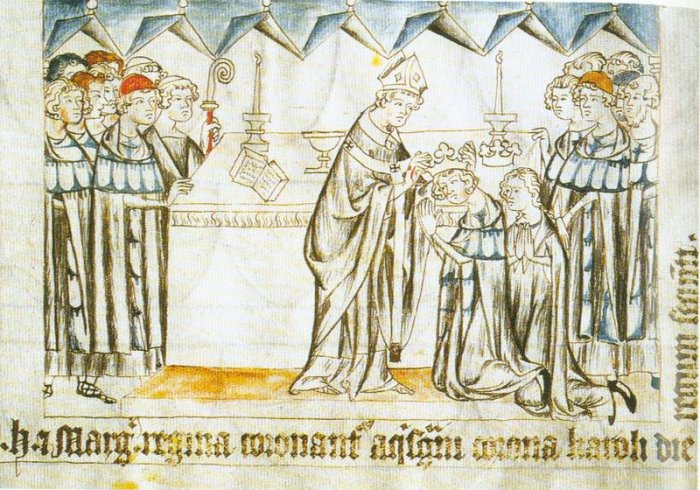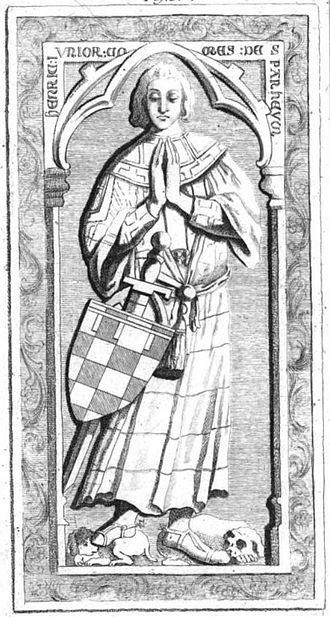Countess Loretta Of Sponheim Kidnapped Archbishop Of Trier And Got Away With It
David Tee - AncientPages.com - Life does not work out well for everyone. In the case of Countess Loretta, hers did not go as she probably planned. Born in either 1290 or 1300 AD, she was widowed after eight years of marriage and was left with three sons.
Castle Starkenburg - Credit: heppenheim.de
Her father-in-law died a year after her husband in 1324, leaving the office of Count vacant. Since the eldest son could not occupy the position of Count, Countess Loretta ruled as regent until he reached the proper age.
It was probably not in her plans either, as the county suffered greatly due to crop failures, migration of the inhabitants to the nearby cities, poverty, and a lack of real money.
Yet rule she did in the best way she could given the state of affairs of her household and that of the Count’s territory. The latter was under constant attack from those neighbors who desired more than their areas.
This unfortunate situation forced Countess Loretta into a test of strength and wills with the powerful Elector Baldwin of Luxembourg, Archbishop of Trier, who happened to be the brother of Henry VII. Henry was the leader of the Holy Roman Empire at that time.
The Archbishop Of Trier Was No Pushover
The archbishopric and electorate of Trier were not some unknown, backwoods, or weak territory. It was the 3rd most powerful archbishopric behind Cologne and Mainz. Being the brother of Henry VII did not hurt.
The Electorate of Trier’s power became the center for monastic learning, and the Jesuits established their college there in 1473. Born Baldwin of Luxembourg, he studied law and theology at the University of Paris.
The coronation of Henry VII and his wife Margaret of Brabant. Loretta's rival Baldwin of Luxembourg, Henry's brother, stands to the left in the scarlet cap. (Margaret’s ample vair-lined peliçon, with its distinctive w-shaped neck, is typical of the sort of garments Loretta would have worn.) Credit: Public Domain
He was elected the Archbishop of Trier in 1307, and the following year, he was confirmed by Pope Clement V. During the years 1324 to 1326, he was one of the four lords in the four lords war, which is where he probably ran afoul of Countess Loretta.
What Is A Kidnapping Between Friends
Because of the situation surrounding her territory, Countess Loretta resorted to desperate measures. But she was known for taking risky moves to protect her late husband’s and son’s territory. In 1326 she had Wildgrave of Kyrburg put in prison for only one reason. He was not loyal to her son.
Wildgrave of Kyrburg remained imprisoned until he capitulated and agreed to be loyal. So kidnapping a powerful man like the Prince-Archbishop of Trier would not seem out of character for Countess Loretta.
The kidnapping took place in 1328 when the Archbishop was traveling. Countess Loretta took him to her Castle Starkenburg. Despite being excommunicated when the news reached Henry VII, Countess Loretta did not release the Archbishop, and there was little he could do.
Tomb sculpture of Loretta's husband. The inscription reads "HENRIC:IVNIOR:COMES:DE: SPANHEIM" (Latin: Henry, the younger Count of Spanheim). "Spanheim" is an older form of "Sponheim." Credit: Public Domain
It seems that being a wife and daughter-in-law of counts was not wasted on Countess Loretta. She had become a very skilled negotiator and would not let the Archbishop go until he had bowed to her demands.
Those demands included- removing the ex-communication, giving up claims to parts of her son’s territories, and of course, money or ransom as it was called. Once these terms were agreed to and fulfilled, Countess Loretta released her kidnapped victim and resumed life as the regent until her son John was old enough to rule in his rightful place.
When she needed to borrow money to help her son’s territory economically, her guarantor was the Archbishop Baldwin of Luxembourg.
Retirement Can Be Good
In 1331, her son John was old enough to assume his duties as Count. He was known as John III of Sponheim-Starkenburg. Countess Loretta did not spend much time meddling in her son’s affairs; she let him rule as he saw fit.
Instead, she busied herself building the Frauenberg, a castle funded by the ransom she had won when she kidnapped Baldwin of Luxembourg. There is no record of how she died. Countess Loretta may have only lived to the age of 56 or 46, depending on what year you accept for her birth.
She was interred in the Cistercian Abbey of Himmerod.
Updated on July 9, 2022
Written by – David Tee AncientPages.com Staff Writer
Copyright © AncientPages.com All rights reserved. This material may not be published, broadcast, rewritten or redistributed in whole or part without the express written permission of AncientPages.com
Expand for referencesMore From Ancient Pages
-
 Ancient Tomb Of ‘Bird Oracle Markos’ Unearthed In Bergama (Pergamon), Turkey
Archaeology | Sep 6, 2022
Ancient Tomb Of ‘Bird Oracle Markos’ Unearthed In Bergama (Pergamon), Turkey
Archaeology | Sep 6, 2022 -
 Ancient Mystery Of The Menorah – Enigmatic Sacred Object With Complex History
Ancient Mysteries | Nov 5, 2018
Ancient Mystery Of The Menorah – Enigmatic Sacred Object With Complex History
Ancient Mysteries | Nov 5, 2018 -
 Ancient Roman Sandal With Nails And Game Pieces Found Under A Playground In Germany
Archaeology | Nov 22, 2024
Ancient Roman Sandal With Nails And Game Pieces Found Under A Playground In Germany
Archaeology | Nov 22, 2024 -
 Underwater City: Unveiling The Secrets At The Bottom Of Fuxian Lake
Ancient Mysteries | Jun 13, 2015
Underwater City: Unveiling The Secrets At The Bottom Of Fuxian Lake
Ancient Mysteries | Jun 13, 2015 -
 Ancient Mammoth Ivory Carving Technology Of Master Craftsmen – Reconstructed
Archaeology | Aug 27, 2020
Ancient Mammoth Ivory Carving Technology Of Master Craftsmen – Reconstructed
Archaeology | Aug 27, 2020 -
 Perperikon – Ancient Secrets Of Bulgaria’s ‘Machu Picchu’ And Europe’s Largest Megalithic Sanctuary
Featured Stories | May 3, 2017
Perperikon – Ancient Secrets Of Bulgaria’s ‘Machu Picchu’ And Europe’s Largest Megalithic Sanctuary
Featured Stories | May 3, 2017 -
 Can This Ancient Coin Solve The Mysterious Disappearance Of Pirate Henry Every?
Archaeology | Apr 1, 2021
Can This Ancient Coin Solve The Mysterious Disappearance Of Pirate Henry Every?
Archaeology | Apr 1, 2021 -
 Aoife: Beautiful Female Warrior, Lover Of Cuchulainn And Mother Of His Only Son In Irish Beliefs
Celtic Mythology | Mar 18, 2019
Aoife: Beautiful Female Warrior, Lover Of Cuchulainn And Mother Of His Only Son In Irish Beliefs
Celtic Mythology | Mar 18, 2019 -
 Bulgaria’s Aquae Calidae Spa Complex: More 40 Coins Dated To 4th Century CE – Found
Archaeology | Jul 24, 2020
Bulgaria’s Aquae Calidae Spa Complex: More 40 Coins Dated To 4th Century CE – Found
Archaeology | Jul 24, 2020 -
 On This Day In History: First Battle Of Reading Took Place – On Jan 4, 871 AD
News | Jan 4, 2017
On This Day In History: First Battle Of Reading Took Place – On Jan 4, 871 AD
News | Jan 4, 2017 -
 Why Did A Solar Eclipse Save George Davidson’s Life In Alaska?
Ancient History Facts | Aug 23, 2024
Why Did A Solar Eclipse Save George Davidson’s Life In Alaska?
Ancient History Facts | Aug 23, 2024 -
 Bandelier National Monument: Unusual Ancient Ruins Of Pueblo People In The Southwest
Civilizations | Jun 30, 2016
Bandelier National Monument: Unusual Ancient Ruins Of Pueblo People In The Southwest
Civilizations | Jun 30, 2016 -
 Leshy: Master Of Forest And Wildlife In Slavic Beliefs
Featured Stories | Mar 25, 2016
Leshy: Master Of Forest And Wildlife In Slavic Beliefs
Featured Stories | Mar 25, 2016 -
 Statuettes Of Gods And Goddesses Unearthed At Ancient Site Of Kültepe
Archaeology | Sep 16, 2020
Statuettes Of Gods And Goddesses Unearthed At Ancient Site Of Kültepe
Archaeology | Sep 16, 2020 -
 ‘Supernatural’ Sized Daughter Of Thera: Rare Masterpiece Of Greek Antiquity Revealed To The Public
Artifacts | Oct 1, 2022
‘Supernatural’ Sized Daughter Of Thera: Rare Masterpiece Of Greek Antiquity Revealed To The Public
Artifacts | Oct 1, 2022 -
 First Bathrooms Appeared Around 8,000 B.C In Scotland
Ancient History Facts | Dec 11, 2016
First Bathrooms Appeared Around 8,000 B.C In Scotland
Ancient History Facts | Dec 11, 2016 -
 Master Kong Confucius: Great Philosopher And ‘Teacher Of All Teachers’ Ahead Of His Time
Featured Stories | Nov 25, 2016
Master Kong Confucius: Great Philosopher And ‘Teacher Of All Teachers’ Ahead Of His Time
Featured Stories | Nov 25, 2016 -
 Why Did King Solomon Hide Advanced Technology In A Secret Place? – The Great Deception – Part 2
Ancient Mysteries | Apr 3, 2021
Why Did King Solomon Hide Advanced Technology In A Secret Place? – The Great Deception – Part 2
Ancient Mysteries | Apr 3, 2021 -
 Drone Footage Reveals Ancient Mesopotamian City Lagash Was Made Of Marsh Islands
Archaeology | Oct 14, 2022
Drone Footage Reveals Ancient Mesopotamian City Lagash Was Made Of Marsh Islands
Archaeology | Oct 14, 2022 -
 Sobekneferu: First Female Pharaoh In Ancient Egypt
Featured Stories | Mar 9, 2019
Sobekneferu: First Female Pharaoh In Ancient Egypt
Featured Stories | Mar 9, 2019



